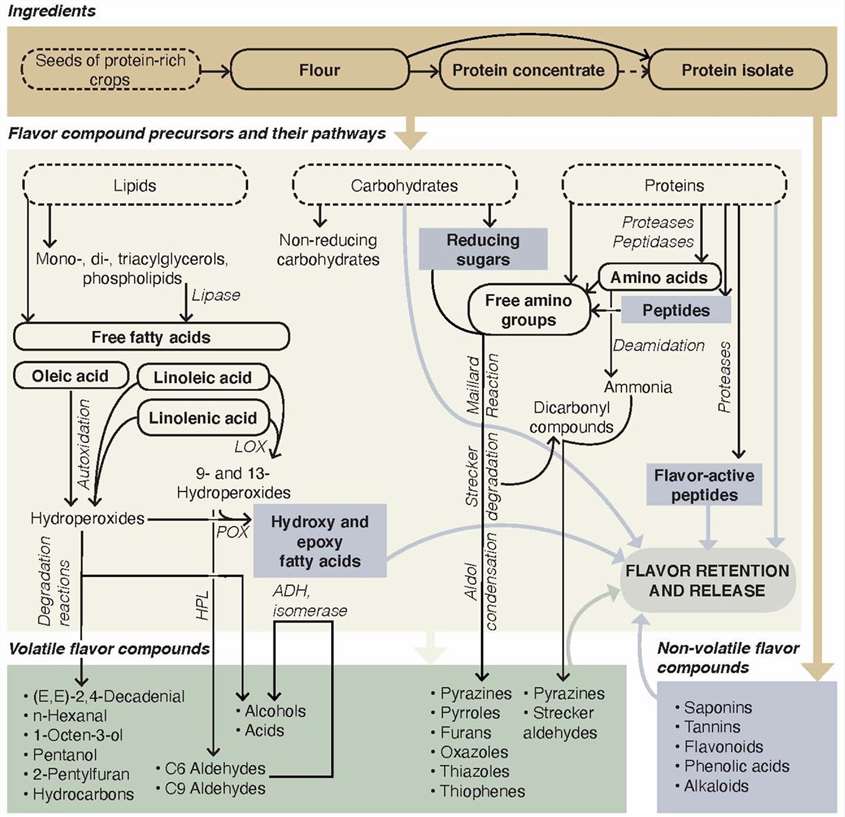Plant materials contain a wide variety of flavor-active compounds, which are often produced as secondary metabolites. Hexanal, octanal, nonanal, 1-hexanol, and octanol have been detected in many different protein-rich plants. In addition, non-volatile taste-active compounds found in plant components, especially legume components, include saponins, tannins, flavonoids, phenolic acids, and alkaloids. These compounds produce bitter, pungent, and astringent flavors. Lipids are also a major contributor to the formation of off-flavors in vegetable protein components. As the demand for developing plant-based meats has increased, the flavor quality of the products has received corresponding attention. However, it is sometimes difficult to accurately assess flavor, including taste and aroma, because highly complex combinations of many compounds may define these factors. Extensive targeted analysis of metabolites and aromatic compounds is a good idea to complete this assessment.
 Fig.1. Principal pathways for the formation of flavor compounds in plant-based meat alternatives. (Li X, et al., 2020)
Fig.1. Principal pathways for the formation of flavor compounds in plant-based meat alternatives. (Li X, et al., 2020)
Like texture and aroma, the flavor is an essential sensory attribute of plant-based meats. To impart meat flavor in plant-based meats, our food scientists and application development experts have been exploring the mechanisms of flavor compound formation in animal meat. Lifeasible focuses on flavor-active compounds (volatile and non-volatile substances) and precursors in various plant protein sources. We try to identify all or some of the key compounds in plant-based meats or to evaluate their flavors by comparing changes in flavor profiles caused by varietal differences, storage or processing, etc.
Lifeasible is a leading partner in flavor assessment of plant-based meats. We have cutting-edge, modern instrumental methods that provide a wealth of information about compounds combined with knowledge of sensory analysis. To develop meat-like flavors, we extract multiple flavor compounds from vegetarian ingredients and analyze them using various methods.
We typically analyze volatile flavor compounds using gas chromatography-mass spectrometry (GC-MS). We offer techniques designed to separate volatile compounds, including vacuum distillation, solvent, supercritical fluid extraction, and headspace solid-phase microextraction (HS-SPME). Our GC-MS analysis allows for the separation, identification, and, to some extent, quantification of individual compounds.
In addition, we use olfactometry in conjunction with GC-MS to analyze flavor compounds in plant-based meats. Trained panelists use powerful olfaction to evaluate the isolated compounds.
Depending on the characteristics of each non-volatile flavor compound, we design specific analytical methods for analysis.
❖ Our selected high-performance liquid chromatography (HPLC) and ultra high performance liquid chromatography (UHPLC) platforms are used for the qualitative or quantitative determination of phenolic compounds and saponins.
❖ We offer colorimetric methods (e.g., vanillin, dimethylaminocinnamaldehyde, and acid-butanol assays) for estimating total condensed tannin content.
❖ For non-volatile lipid degradation products, we typically extract with organic solvents, followed by preparative chromatographic separation and final analysis by HPLC/UHPLC and ELSD or MS detection.
We offer fermentation technology to improve the aroma characteristics and reduce the formation of off-flavors in vegetable protein ingredients. We have successfully used this technology to mask or reduce bitter and bean-like flavors in isolated soy, pea, and lupine proteins and related products.
Our LC-MS, and GC-MS allows us to evaluate the flavor qualities of plant-based meat products, including flavor and aroma. In addition, the combination of these data allows us to assess the overall quality of the product. This strategy is applicable not only to plant-based meats but to all food qualities. We aim to help our customers develop satisfying plant-based meats with organoleptic properties similar to those of meat. Feel free to contact us for more information.
Reference